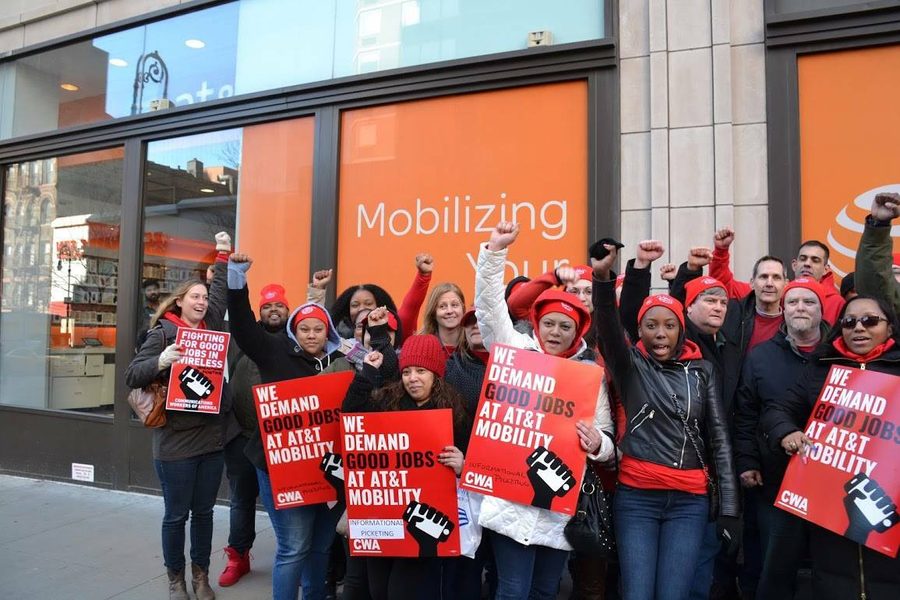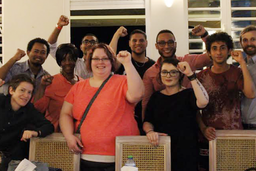
This article was first posted by Labor Notes.
AT&T Mobility workers are waging their largest-ever contract mobilization. In retail stores and call centers across the country they’re sporting “We Demand Good Jobs” buttons, picketing on their days off, plastering union flyers on their lockers, and blowing up Facebook with pictures of their activities. These actions are helping knit together a sense of solidarity among 21,000 union members dispersed throughout 36 states.
“They’ve taken the career out of this job,” says Heather Trainor of Communications Workers (CWA) Local 1101 in New York City. “Now they just want to put a body in the store to make them money. They’ve forgotten that we’re human beings.”
Mobility is AT&T’s wireless division. Workers here sell phones and help with service questions at retail stores, provide tech and billing support in call centers, and build and repair the company’s wireless infrastructure.
Trainor, now a business agent with the local, started working in retail at AT&T Mobility 15 years ago, when it was still Cingular. “I was a single mother,” she said, “and this was a good-paying job, with fair wages, fair commissions, and good benefits. I could even afford to go down to the Jersey Shore once a year on vacation.
“But now they’re making us work more and sell more and make less. Commissions are cut in half, we can’t afford the medical, and we can’t afford to go on vacation.”
Their contract, known as the “Orange Contract” thanks to the color of the cover, was set to expire February 11, but the company and union agreed to an extension, which can be canceled with 72 hours’ notice from either side. In February, workers voted 93 percent yes to authorize a strike if necessary.
While other wireless companies are largely non-union, CWA represents 45,000 AT&T wireless employees, thanks to bargain-to-organize agreements that allowed for card-check neutrality or quick union elections. At Verizon Wireless, CWA represents a group of 100 technicians in New York and workers at the company’s Brooklyn retail stores, who struck alongside 39,000 wireline workers last spring. The union also has an ongoing minority-union campaign at T-Mobile.
Outsourcing battle
Just like at Verizon, the union is fighting to halt AT&T’s offshoring of call center jobs. It’s also fighting the growth of nonunion “authorized retailers” in place of corporate-owned retail stores.
“Just this past month, in January, they closed down one of our mall locations,” said Jim Morris, who works in sales support at a Mobility store in Carmel, Indiana. An authorized dealer took its place.
Authorized retailers are notoriously short-staffed and pay much lower wages, putting even greater pressure on workers there to focus on sales, with much less oversight of their practices.
Adding insult to injury, the proliferation of this type of store adds to the workload of union members at corporate locations. “They keep referring customers to our store after making a sale, and we have to fix everything they do wrong,” says Yesenia Gonzalez, who’s worked for six years at a Mobility store in Orange, California.
Changes to the commission policy also have workers fired up. Last year AT&T Mobility put a cap on the commission workers can earn, though workers say the new commission structure pays them so much less for the same amount of work that it’s impossible to even reach the cap.
“I haven’t met a retail sales consultant who made more last year than the previous year,” says Gonzalez, one of four Local 9510 area stewards covering 26 Mobility stores. She says many workers are making thousands of dollars less than they did in prior years.
“It’s hard working for a company when you don’t know how much you’re going to make every month,” Gonzalez says.
Meanwhile in the call centers, workers face constantly shifting benchmarks. “They’re making it very hard to reach a bonus at the end of the month,” says Patty Shaw, a call center worker and member of Local 4900 in Evansville, Indiana. Her call center handles iPhone advanced tech support. Since she started there a little over two years ago, Shaw says, the company has changed the way it calculates eligibility for bonuses three times.
AT&T made $13 billion in profits in 2016, while in 2015 CEO Randall Stephenson raked in $25 million in total compensation; his haul for 2016 has yet to be revealed. The company controls 30 percent of the U.S. wireless subscriber market, putting it at number two behind Verizon. And AT&T just keeps growing — after gobbling up DirecTV in a $67 billion merger in 2015, it’s now awaiting regulatory approval to buy entertainment giant Time Warner for $85 billion.
Don’t get sick
Mobility workers across the board are indignant at a new attendance policy rolled out last year. Workers are fired if they accumulate eight “points” in a 12-month period. They get one point for every day they’re out sick, unless their absence qualifies under the Family Medical Leave Act.
“Our attendance policy is atrocious,” says Morris. “Any common illness, flu, or cold — a couple of those a year and you can get fired. People do one of two things: they get fed up with this stuff and get another job, or you’ll come to work sick and get everybody else sick.”
Morris knows a thing or two about the attendance policy. He’s been with the company for 25 years, and was once a manager in the store he now works in. “When I was a manager I had to tell people that if they were going to be sick, we couldn’t have them working here,” he said.
AT&T insists it doesn’t have to bargain over changes to commissions or the attendance policy, since those issues are only covered in letters of agreement — with broad, management-friendly language — appended to the contract. That’s something workers would like to change in this round of negotiations.
The union is also fighting company proposals to force members to pay for 32 percent of their medical benefits by 2021 and to stop paying workers for the first day they miss during any illness.
Mobilization
The majority of the 21,000 Mobility workers are employed at retail stores, making this one of the largest unionized retail workforces in the country. It’s a starkly different group than the wireline workers who’ve traditionally made up the bulk of CWA’s telecom members.
The typical retail store has around a dozen union members, and they’re never all there at the same time. Garages or call centers, meanwhile, often have hundreds of workers on the same shift. Retail workers also tend to be younger, with much higher turnover.
Embracing these challenges, CWA has put more resources than ever before into internal organizing of its Mobility membership. “We did what the company didn’t want us to do,” Trainor says, “which is to educate a younger workforce and tell them they have rights.”
In 2014 the union launched “Unity at Mobility” classes, two six-hour sessions in which thousands of members have learned about their rights on the job, the history of the labor battles in telecom, and how to get more active in the union, including becoming a steward or a contact in a store.
“We never had this kind of representation in Mobility,” says Trainor, who was the sole chief steward for 1101’s 1,500 Mobility members a decade ago. “Now we have 10 chief stewards and 100 stewards, plus a whole executive board that is visiting stores and call centers and doing a lot of mobilizing work.”
The union is also working to unite Mobility workers from across the country. During this round of negotiations CWA has brought hundreds of members together for national trainings. It’s been posting mobilization snapshots on its Unity at AT&T Mobility Facebook page. And on the eve of the contract expiration date in February, CWA held rallies in front of dozens of Mobility stores, and thousands of workers called their area managers to demand a good contract.
Good jobs
In Tridelphia, West Virginia, Local 2006 bought plastic tablecloths in CWA’s trademark red, which members are putting as backdrops at their workstations. The local represents 160 call center workers who provide Android tech support, plus workers in three Mobility stores.
“There’s a lot of people that are scared about the call center closing down, and jobs going overseas,” says Local 2006 President Ann Vogler, who’s worked at the call center for nine years. “Around here there’s the coal mines, but there’s been so many layoffs. Working at this call center has given people the ability to support their families — and there’s a lot of people who work in that call center whose income is the only income for their family.”
Ninety-five percent of the local’s call center members wore black on the first day of bargaining. “That day the managers went into a meeting, and when they were in the meeting, we went around and put black streamers around their offices,” says Vogler.
To show they were tired of getting screwed, the workers put a bottle of KY Jelly on the area manager’s desk — along with some black confetti on his desk and red balloons in his office for good measure.
According to the union, AT&T has eliminated 8,000 call center jobs since 2011. Many of those jobs have been sent to the Dominican Republic, El Salvador, Mexico, and the Philippines. The latter is now the call center capital of the world, with 1.2 million workers.
A CWA delegation visited the Philippines during the Verizon strike, after call center workers there reached out to the union through its Stand Up to Verizon Facebook page. Filipino workers at a couple of Verizon contractors organized a slowdown and overtime boycott during the strike.
CWA has continued to support call center organizing in the Philippines and other countries. After an AT&T vendor in the Dominican Republic threatened to fire activist Oliver Benson, the union mobilized members and supporters to share solidarity messages on Facebook and Twitter the day the vendor, Teleperformance, held its shareholder meeting. Benson had been speaking out on social media about how AT&T and Verizon have used outsourcing to attack workers’ rights.
The Verizon example had the same effect on AT&T call center workers in West Virginia as it did on workers halfway around the world. “We had about 10 people who would go over and picket out in front of the Verizon store during the strike,” Vogler said. “I think it inspired them a lot to get involved.”
Time will tell whether AT&T workers will be forced to go down the same road as their Verizon brothers and sisters.
Full disclosure: In These Times staff are members of the Communication Workers of America, and the union is a sponsor of the magazine. Sponsors play no role in editorial content.







